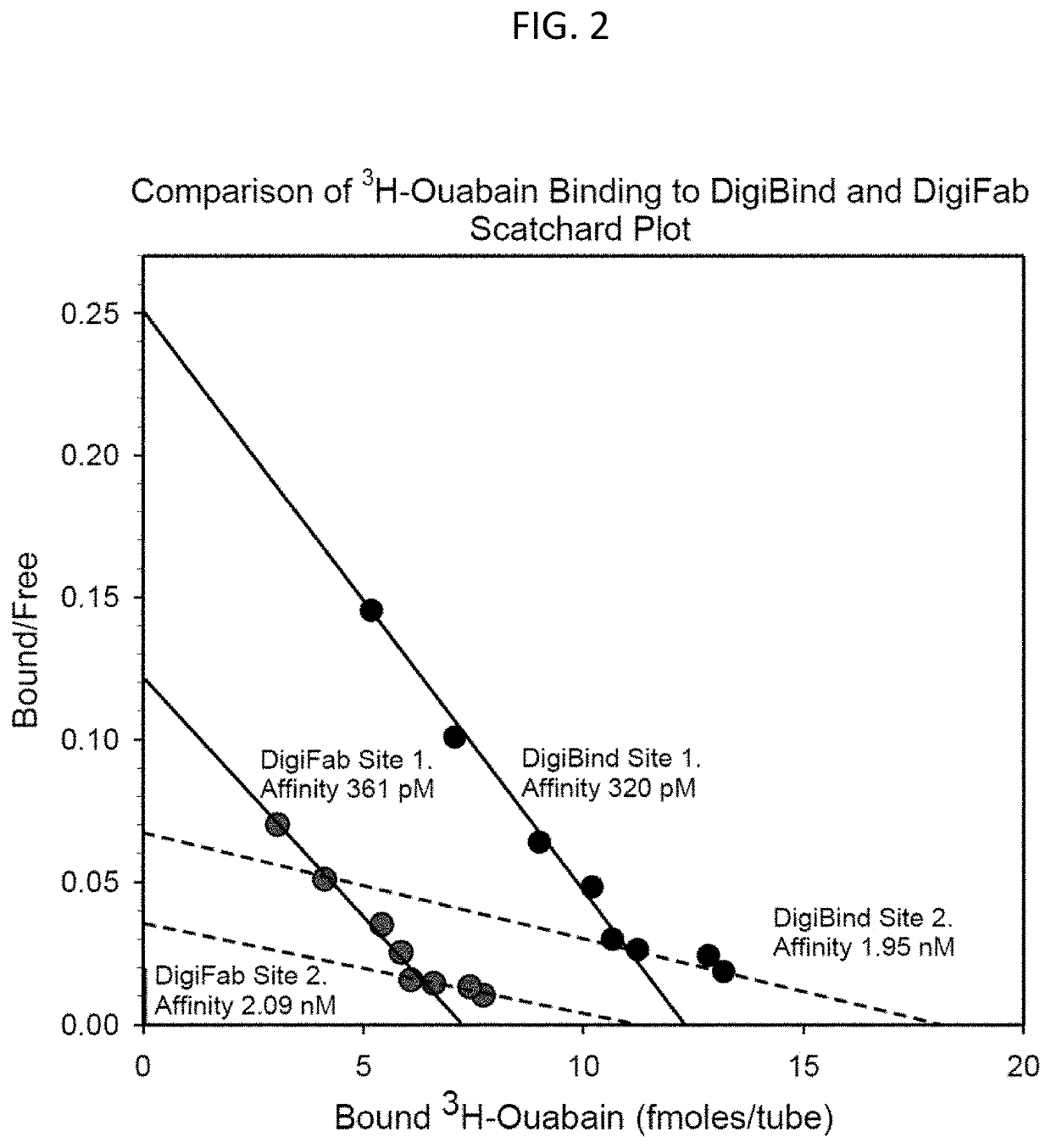Methods for preventing acute kidney injury
a kidney injury and acute technology, applied in the field of medicine and pharmaceuticals, can solve the problems of unmet need for a solution, no effective treatment for aki, and unknown mechanisms underlying maternal and fetal pathologies in preeclampsia
- Summary
- Abstract
- Description
- Claims
- Application Information
AI Technical Summary
Benefits of technology
Problems solved by technology
Method used
Image
Examples
example 1
DIGIFAB on Plasma Creatinine in Rats Following Renal Ischemia and Reperfusion (RIR)
[0196]Male Wistar ICS rats (˜300 g) on normal diet were implanted on “Day 0” with a subcutaneous minipump to deliver ouabain—see FIG. 7—(10 μg / kg / day; open symbols) or vehicle (6 μl / day; solid symbols). Beginning on Day 13, half of the ouabain-infused rats and half of the vehicle-infused rats were injected with DIGIFAB (triangles), and the remainder (circles) were injected with an equal volume of saline: The DIGIFAB-treated rats received 0.2 ml DIGIFAB (10 mg / ml) at 15 hr and 6 hr, and 0.1 ml DIGIFAB 1 hr pre-operatively. On Day 15, at the appropriate time following the DIGIFAB or Saline injections, the rats underwent a laparotomy and bilateral renal pedicle clamping for 45 min (RIR surgery; both renal arteries, renal veins and ureters were clamped). The rats were then permitted to recover with the usual post-op care. Bloods were drawn for plasma creatinine measurements: on Day 0 before minipump impla...
example 2
f DIGIFAB on Blood Pressure in Salt-Restricted Rats
[0209]We postulate that lowering plasma EO with DIGIFAB prior to and during CPB surgery should reduce the incidence of post-operative (post-op) AKI and, thus, reduce post-op morbidity and mortality. It is prudent to verify, in an animal model, that, if EO is elevated, DIGIFAB does not cause the BP to drop precipitously. Importantly, DIGIFAB is approved for clinical use. It has very few side-effects, and a precipitous drop in BP has not been reported with its use, even in patients with heart failure (Chan & Buckley, Clin Toxicol (Phila) 52: 824-836, 2014; Schaeffer et al., J Am Osteopath Assoc 110: 587-592, 2010).
[0210]In a control experiment, the effects of DIGIFAB and CroFab were tested on mean blood pressure (MBP monitored by telemetry) in normal wild-type C57Bl / 6 mice (with normal plasma EO). [Note: CroFab, anti-crotalus toxin fab fragments, was employed as a Fab control because CroFab is generated in a similar manner to DIGIFAB....
example 3
tive Administration of DIGIFAB to Prevent Acute Kidney Injury in Patients Undergoing CABG Surgery
[0231]The effect of pre-operative administration of DIGIFAB (vs vehicle alone) on the rise in serum creatinine (a measure of kidney function / injury) and several parameters of AKI in patients undergoing CABG surgery is tested.
[0232]The trial is double-blinded, and involves 250 high risk (with diabetes and / or a renal glomerular filtration rate <60 ml / min) patients undergoing CABG surgery. Pre-op and post-op serum creatinine and plasma EO is measured. Half the subjects receive two doses of DIGIFAB (3.5 mg / kg), one at 12-15 hrs pre-op, and the second at 1 hr pre-op; half the subjects receive 2 ‘doses’ of vehicle. This study tests the hypothesis that pre-op DIGIFAB will attenuate the post-op rise in serum creatinine and evidence of AKI that often accompanies CABG surgery.
PUM
| Property | Measurement | Unit |
|---|---|---|
| systolic blood pressure | aaaaa | aaaaa |
| time | aaaaa | aaaaa |
| time | aaaaa | aaaaa |
Abstract
Description
Claims
Application Information
 Login to View More
Login to View More - R&D
- Intellectual Property
- Life Sciences
- Materials
- Tech Scout
- Unparalleled Data Quality
- Higher Quality Content
- 60% Fewer Hallucinations
Browse by: Latest US Patents, China's latest patents, Technical Efficacy Thesaurus, Application Domain, Technology Topic, Popular Technical Reports.
© 2025 PatSnap. All rights reserved.Legal|Privacy policy|Modern Slavery Act Transparency Statement|Sitemap|About US| Contact US: help@patsnap.com



